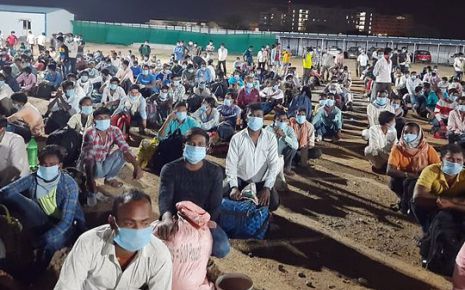Evolution Of Labour Legislations In India
"A nation may do without its millionaires and without its capitalists but a
nation can never do without its labour" - Mahatma Gandhi
Law is the backbone that governs the working of a nation and leads to the development or the downfall of the country. This development in the industrial sector is all because of the significant human force behind it, i.e, the labour working and leading the premise to a better stage.
The growth of the nation is thus tied to the hardworking hands of the labour. In all aspects and contexts, labour law has flourished and thus helped the labour and their oppressed voice against the capitalists who have continuously tried to abuse the man force behind the actual operations. This paper has thus highlighted the change in the legislation which has led to the betterment of labour in India today.
Introduction
Assessing the scope of India's labour laws and their impact on employee welfare is a daunting task. The implementation of state-level policies from 2000 to 2020 has had a significant impact on the welfare of workers in India. To this end, India has a comprehensive set of labour laws that govern the rights of workers and protect their welfare.
Such laws are designed to ensure that workers are not exploited and are provided with a safe and secure working environment. They also provide for the regulation of wages and working hours, as well as the provision of benefits such as health insurance and pensions. The enforcement of these laws is critical in order to ensure that workers are not subjected to unfair or exploitative working conditions.
Furthermore, the enforcement of these laws is also necessary to ensure that employees are not subjected to discrimination based on gender, religion, caste or ethnicity. Thus, the assessment of India's labour laws and their impact on employee welfare is an important step in ensuring that workers are provided with a safe and secure working environment.
Background
The history of British colonialism serves as the foundation for labor legislation in India. Indian laborers safeguarded British employers' interests and helped the Britishers establish their dominance in India. Given that Britishers were few and it was impossible to control the entire country, Indian laborers helped establish industries. The Assamese plantation industry, where professionals recruited workers, was the initial target of legislative control.
Additionally, these workers were prohibited from leaving the garden. Then, as a result of British exploitation, Indian labor became increasingly burdened, and as a result, British textiles faced increased competition in the export market. As a result, the Factories Act of 1883 was enacted by the British Parliament to increase labor costs solely to alleviate pressure.
In addition, this law granted Indian labor some fundamental freedoms, including the right to work eight hours a day, the prohibition of child labor, the prohibition of women working at night, and overtime pay for additional work beyond eight hours. The Workmen Compensation Act of 1923, the Mines Act of 1923, the Forced Labor Act of 1930, and the Payment of Wages Act of 1936 were just a few of the many labor-related laws that India passed in preparation for independence.
Indian labor standards were at their poorest after independence. They were viewed as livestock, paid very little for their job, and even their medical problems were ignored, stripping them of their rights. In India, the price of living has also risen since the partition.
As a result, several individuals spoke out against it. They organized numerous groups in the hope of striking alongside unions. Finally, in 1950, laws associated with workmen were enshrined in the constitution, protecting their basic human rights, and dealing with their medical issues, such as the Minimum Wages Act 1948, Factories Act 1948, and Employees State Insurance Act 1948.
Concept
In June 2013, the Indian parliament passed a new Labour Laws Bill. The passing of this bill was an important milestone in India's journey toward establishing a statutory protection system for workers. Labour laws have always been a top priority for India's government as they are essential in creating a just working environment for all workers. In fact, the Minimum Wage Act has been in effect since 1938 and the Factories Act since 1948.
All major Indian states had legislated labour laws by their judicial bodies by the end of the first quarter of 2014. All major Indian states passed legislated labour laws by their judicial bodies at the end of 2013. These laws are now being implemented in the industries within those states. For instance, at the end of 2013, Bihar enacted its Industrial Employment Regime (IER) law.
This law has ensured that workers are fairly compensated for injuries they sustain on the job and provided for regular inspections and audits of workplaces to ensure this is happening. In addition, Gujarat has enacted a law ensuring that workers receive their wages on time and without delay. These laws are helpful in preventing companies from exploiting workers without consequences- which is why so many states are passing them in the first place.
However, there are many more laws in progress and being drafted to better the working conditions of workers in India. For instance, while the IER is being implemented in Bihar, government authorities are also conducting investigations into multiple cases of violations under this law as they prepare to prosecute violators.
Other pending labour laws being drafted include those pertaining to industrial accidents, maternity leave, and health and safety standards in factories. These are being drafted with the intent of protecting both workers and consumers alike. Once enacted, these new laws will greatly improve working conditions for millions of Indians who labor for us every day.
It features aspects created exclusively suiting personnel. In some aspects, India's labour regulations are comparable to those of industrialized capitalist civilizations. Several statutes control areas such as welfare benefits, wellness and protection at work, and statutory guidelines. Nevertheless, India's labour laws only apply to a tiny portion of the country's workers, and sometimes among that segment, overall implementation is restricted.
Consolidating several labour rules is a huge step towards making adherence easier. Because of the streamlining of definitions and the broadening of protection to incorporate the unorganised sector, the perks of the law shall be accessible to a bigger labour pool.
Despite the fact that it took ages, the reform should pave the way for even greater reforms in the upcoming times, simplifying the process for Indian organisations to do business, generating employment, and impacting the nation's economic interactions in the future.
While discussing employee rights in India, one should always take into account not only the implementation of a collection of cheap labour legislative or organizational standards in a certain society. Furthermore, it necessitates considering the interpretation of "labour law" in a wide range of commercial and societal circumstances. Indian labour legislation is comparable to those of industrialised advanced economies in certain aspects.
It has a plethora of regulations governing minimum wage, income support, employee welfare, and other topics. Its labour legislation provides a lawful mechanism for workplace conflict and legalises collective bargaining and associated operations. It legalises protests for the benefit of the common welfare.
Furthermore, we already discovered that, the labour legislation effectively pertains to a relatively tiny percentage of the Indian working population, while perhaps amongst that proportion, its implementation is, to phrase it bluntly, inefficient. In reality, none of the main specific goals of the labour circuit of justice described in this study seems to have actually been met. As an outcome, this mechanism is effectively unusable.
Emerging challenges
McKinsey Global Institute (2016) estimates that 10-15% of working-age persons in the United States and the European Union make their primary income through "independent labour" based on official figures. In addition to traditional freelance labour, developing digital platforms that enable task-based "crowd-work" (e.g., freelance work via digital platforms) and "on-demand work" would be examples of independent employment (e.g., taxi and restaurant aggregators).
One of the issues that the Codes must address is whether a distinction should be made between self-employed individuals (e.g., freelancers) who exercise independent control over their work (including terms of service, scheduling, and payment terms) and self-employed individuals who primarily work with a single platform that may exert some degree of control over the terms of their work (e.g. aggregators).
It should be noted that employees in the service sector are often categorised as independent consultants and so do not have access to many labour regulations, including government benefits. Some areas throughout the world have established guidelines for identifying employer-employee interactions that may be misclassified as independent contract labour.
For example, in 2019, California passed legislation that qualifies certain contract employees as employees and authorizes them to advantages such as health insurance if the hiring company fails to demonstrate that:
Conclusion
Indian courts have also started to enforce and implement Labour Laws Act from 1950 with severe punishment like imprisonment along with an amount which is Rs 20 lakhs per worker when any business company or industrial house ignores it or not giving minimum wages to its worker or not giving minimum benefits like food, housing, etc. Along with the payment of fines, every business house violating this act can be prosecuted according to the number of labour under this act.
To implement these act judicial officers along with labour department officer works under district magistrate where as judicial officers work under state magistrate. Whereas labor department officers work under the state labor commissioner whereas labour commissioner works under the secretary general of the government whereas the secretary general works under the prime minister's office so that he can check all government business house not following minimum wages or not giving minimum benefits to its worker or making illegal employment or not paying employees on time which is illegal according to Indian constitution act.
The new Labour Laws Bill passed by parliament was an important development in India's fight against economic exploitation- but it's far from the only step forward being taken right now. The new legal framework will help protect Indian workers from abuse while also creating incentives for businesses to comply with minimum standards of decency and fairness towards employees. It's exciting to watch these laws take effect and improve life of millions of working Indians.
References:
Law is the backbone that governs the working of a nation and leads to the development or the downfall of the country. This development in the industrial sector is all because of the significant human force behind it, i.e, the labour working and leading the premise to a better stage.
The growth of the nation is thus tied to the hardworking hands of the labour. In all aspects and contexts, labour law has flourished and thus helped the labour and their oppressed voice against the capitalists who have continuously tried to abuse the man force behind the actual operations. This paper has thus highlighted the change in the legislation which has led to the betterment of labour in India today.
Introduction
Assessing the scope of India's labour laws and their impact on employee welfare is a daunting task. The implementation of state-level policies from 2000 to 2020 has had a significant impact on the welfare of workers in India. To this end, India has a comprehensive set of labour laws that govern the rights of workers and protect their welfare.
Such laws are designed to ensure that workers are not exploited and are provided with a safe and secure working environment. They also provide for the regulation of wages and working hours, as well as the provision of benefits such as health insurance and pensions. The enforcement of these laws is critical in order to ensure that workers are not subjected to unfair or exploitative working conditions.
Furthermore, the enforcement of these laws is also necessary to ensure that employees are not subjected to discrimination based on gender, religion, caste or ethnicity. Thus, the assessment of India's labour laws and their impact on employee welfare is an important step in ensuring that workers are provided with a safe and secure working environment.
Background
The history of British colonialism serves as the foundation for labor legislation in India. Indian laborers safeguarded British employers' interests and helped the Britishers establish their dominance in India. Given that Britishers were few and it was impossible to control the entire country, Indian laborers helped establish industries. The Assamese plantation industry, where professionals recruited workers, was the initial target of legislative control.
Additionally, these workers were prohibited from leaving the garden. Then, as a result of British exploitation, Indian labor became increasingly burdened, and as a result, British textiles faced increased competition in the export market. As a result, the Factories Act of 1883 was enacted by the British Parliament to increase labor costs solely to alleviate pressure.
In addition, this law granted Indian labor some fundamental freedoms, including the right to work eight hours a day, the prohibition of child labor, the prohibition of women working at night, and overtime pay for additional work beyond eight hours. The Workmen Compensation Act of 1923, the Mines Act of 1923, the Forced Labor Act of 1930, and the Payment of Wages Act of 1936 were just a few of the many labor-related laws that India passed in preparation for independence.
Indian labor standards were at their poorest after independence. They were viewed as livestock, paid very little for their job, and even their medical problems were ignored, stripping them of their rights. In India, the price of living has also risen since the partition.
As a result, several individuals spoke out against it. They organized numerous groups in the hope of striking alongside unions. Finally, in 1950, laws associated with workmen were enshrined in the constitution, protecting their basic human rights, and dealing with their medical issues, such as the Minimum Wages Act 1948, Factories Act 1948, and Employees State Insurance Act 1948.
Concept
In June 2013, the Indian parliament passed a new Labour Laws Bill. The passing of this bill was an important milestone in India's journey toward establishing a statutory protection system for workers. Labour laws have always been a top priority for India's government as they are essential in creating a just working environment for all workers. In fact, the Minimum Wage Act has been in effect since 1938 and the Factories Act since 1948.
All major Indian states had legislated labour laws by their judicial bodies by the end of the first quarter of 2014. All major Indian states passed legislated labour laws by their judicial bodies at the end of 2013. These laws are now being implemented in the industries within those states. For instance, at the end of 2013, Bihar enacted its Industrial Employment Regime (IER) law.
This law has ensured that workers are fairly compensated for injuries they sustain on the job and provided for regular inspections and audits of workplaces to ensure this is happening. In addition, Gujarat has enacted a law ensuring that workers receive their wages on time and without delay. These laws are helpful in preventing companies from exploiting workers without consequences- which is why so many states are passing them in the first place.
However, there are many more laws in progress and being drafted to better the working conditions of workers in India. For instance, while the IER is being implemented in Bihar, government authorities are also conducting investigations into multiple cases of violations under this law as they prepare to prosecute violators.
Other pending labour laws being drafted include those pertaining to industrial accidents, maternity leave, and health and safety standards in factories. These are being drafted with the intent of protecting both workers and consumers alike. Once enacted, these new laws will greatly improve working conditions for millions of Indians who labor for us every day.
Protection Of Labour
Laborers' fights for righteous due rights and livelihoods contributed to the formation of labour legislation all throughout the world. They got into fights to secure themselves and better their basic situations. The area of labour law is constantly growing and holds a distinctive place in the minds inside the legal community.It features aspects created exclusively suiting personnel. In some aspects, India's labour regulations are comparable to those of industrialized capitalist civilizations. Several statutes control areas such as welfare benefits, wellness and protection at work, and statutory guidelines. Nevertheless, India's labour laws only apply to a tiny portion of the country's workers, and sometimes among that segment, overall implementation is restricted.
Consolidating several labour rules is a huge step towards making adherence easier. Because of the streamlining of definitions and the broadening of protection to incorporate the unorganised sector, the perks of the law shall be accessible to a bigger labour pool.
Despite the fact that it took ages, the reform should pave the way for even greater reforms in the upcoming times, simplifying the process for Indian organisations to do business, generating employment, and impacting the nation's economic interactions in the future.
While discussing employee rights in India, one should always take into account not only the implementation of a collection of cheap labour legislative or organizational standards in a certain society. Furthermore, it necessitates considering the interpretation of "labour law" in a wide range of commercial and societal circumstances. Indian labour legislation is comparable to those of industrialised advanced economies in certain aspects.
It has a plethora of regulations governing minimum wage, income support, employee welfare, and other topics. Its labour legislation provides a lawful mechanism for workplace conflict and legalises collective bargaining and associated operations. It legalises protests for the benefit of the common welfare.
Furthermore, we already discovered that, the labour legislation effectively pertains to a relatively tiny percentage of the Indian working population, while perhaps amongst that proportion, its implementation is, to phrase it bluntly, inefficient. In reality, none of the main specific goals of the labour circuit of justice described in this study seems to have actually been met. As an outcome, this mechanism is effectively unusable.
Emerging challenges
McKinsey Global Institute (2016) estimates that 10-15% of working-age persons in the United States and the European Union make their primary income through "independent labour" based on official figures. In addition to traditional freelance labour, developing digital platforms that enable task-based "crowd-work" (e.g., freelance work via digital platforms) and "on-demand work" would be examples of independent employment (e.g., taxi and restaurant aggregators).
One of the issues that the Codes must address is whether a distinction should be made between self-employed individuals (e.g., freelancers) who exercise independent control over their work (including terms of service, scheduling, and payment terms) and self-employed individuals who primarily work with a single platform that may exert some degree of control over the terms of their work (e.g. aggregators).
It should be noted that employees in the service sector are often categorised as independent consultants and so do not have access to many labour regulations, including government benefits. Some areas throughout the world have established guidelines for identifying employer-employee interactions that may be misclassified as independent contract labour.
For example, in 2019, California passed legislation that qualifies certain contract employees as employees and authorizes them to advantages such as health insurance if the hiring company fails to demonstrate that:
- The activities undertaken by the individual tumble beyond the usual course of the company's performance,
- The firm does not retain control over the direction in which the worker acts their tasks, and
- The user is conventionally engaged in a trade or business.
Conclusion
Indian courts have also started to enforce and implement Labour Laws Act from 1950 with severe punishment like imprisonment along with an amount which is Rs 20 lakhs per worker when any business company or industrial house ignores it or not giving minimum wages to its worker or not giving minimum benefits like food, housing, etc. Along with the payment of fines, every business house violating this act can be prosecuted according to the number of labour under this act.
To implement these act judicial officers along with labour department officer works under district magistrate where as judicial officers work under state magistrate. Whereas labor department officers work under the state labor commissioner whereas labour commissioner works under the secretary general of the government whereas the secretary general works under the prime minister's office so that he can check all government business house not following minimum wages or not giving minimum benefits to its worker or making illegal employment or not paying employees on time which is illegal according to Indian constitution act.
The new Labour Laws Bill passed by parliament was an important development in India's fight against economic exploitation- but it's far from the only step forward being taken right now. The new legal framework will help protect Indian workers from abuse while also creating incentives for businesses to comply with minimum standards of decency and fairness towards employees. It's exciting to watch these laws take effect and improve life of millions of working Indians.
References:
- Impact of Special Economic Zones on Employment, Poverty and Human
Development, Econstor, last visited on 13th February,2023, available at:
https://www.econstor.eu/handle/10419/176213 - India: India's New Labour Codes- By Far The Biggest Change To Labour
Laws In Indian History? Mondaq, last visited on 13th February,2023, available at:
https://www.mondaq.com/india/employee-benefits-compensation/1208322/india39s-new-labour-codes-by-far-the-biggest-change-to-labour-laws-in-indian-history - The Workmen Compensation Act, 1923, No. 8, Acts of Parliament, 1923 (India).
- Indian Mines Act, 1923, No. 4, Acts of Parliament, 1923 (India).
- Forced Labor Act, 1930, No. 29, Acts of Parliament, 1930 (India).
- Payment of Wages Act, 1936, No. 4, Acts of Parliament, 1936 (India).
- Minimum Wages Act, 1948, No. 11, Acts of Parliament, 1948 (India).
- The Factories Act, 1948, No. 63, Acts of Parliament, 1948 (India).
- Employees State Insurance Act, 1948, No. 34, Acts of Parliament, 1948 (India).
- Overview of Labour Law Reforms", PRS Legislative Research, last visited on 12th
February, 2023, available at:
https://prsindia.org/billtrack/overview-of-labour-law-reforms - Labour Laws In India, National Crime Investigation Bureau, last visited on
13th February,2023, available at:
https://ncib.in/pdf/ncib_pdf/Labour%20Act.pdf - Independent Work: Choice, Necessity, And The Gig Economy, McKinsey Global
Institute, 2016, last visited on 12th February, 2023, available at:
https://www.mckinsey.com/~/media/McKinsey/ Independent-Work-Choice-necessity-and-the-gig-economy-Full-report.pdf - Bill Text - AB-5 Worker status: employees and independent contractors.,
California Legislative Information, last visited on 12th February, 2023,
available at:
https://leginfo.legislature.ca.gov/faces/billNavClient.xhtml?bill_id=201920200AB5
Law Article in India
Legal Question & Answers
Lawyers in India - Search By City
LawArticles
How To File For Mutual Divorce In Delhi

How To File For Mutual Divorce In Delhi Mutual Consent Divorce is the Simplest Way to Obtain a D...
Increased Age For Girls Marriage

It is hoped that the Prohibition of Child Marriage (Amendment) Bill, 2021, which intends to inc...
Facade of Social Media

One may very easily get absorbed in the lives of others as one scrolls through a Facebook news ...
Section 482 CrPc - Quashing Of FIR: Guid...

The Inherent power under Section 482 in The Code Of Criminal Procedure, 1973 (37th Chapter of t...
The Uniform Civil Code (UCC) in India: A...

The Uniform Civil Code (UCC) is a concept that proposes the unification of personal laws across...
Role Of Artificial Intelligence In Legal...

Artificial intelligence (AI) is revolutionizing various sectors of the economy, and the legal i...








Please Drop Your Comments